 |
| June 08, 2021 | Volume 17 Issue 22 |
Mechanical News & Products
Designfax weekly eMagazine
Archives
Partners
Manufacturing Center
Product Spotlight
Modern Applications News
Metalworking Ideas For
Today's Job Shops
Tooling and Production
Strategies for large
metalworking plants
What's a SLIC Pin®? Pin and cotter all in one!
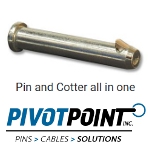 The SLIC Pin (Self-Locking Implanted Cotter Pin) from Pivot Point is a pin and cotter all in one. This one-piece locking clevis pin is cost saving, fast, and secure. It functions as a quick locking pin wherever you need a fast-lock function. It features a spring-loaded plunger that functions as an easy insertion ramp. This revolutionary fastening pin is very popular and used successfully in a wide range of applications.
The SLIC Pin (Self-Locking Implanted Cotter Pin) from Pivot Point is a pin and cotter all in one. This one-piece locking clevis pin is cost saving, fast, and secure. It functions as a quick locking pin wherever you need a fast-lock function. It features a spring-loaded plunger that functions as an easy insertion ramp. This revolutionary fastening pin is very popular and used successfully in a wide range of applications.
Learn more.
Engineering challenge: Which 3D-printed parts will fade?
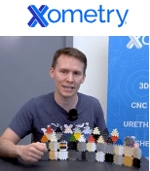 How does prolonged exposure to intense UV light impact 3D-printed plastics? Will they fade? This is what Xometry's Director of Application Engineering, Greg Paulsen, set to find out. In this video, Paulsen performs comprehensive tests on samples manufactured using various additive processes, including FDM, SLS, SLA, PolyJet, DLS, and LSPc, to determine their UV resistance. Very informative. Some results may surprise you.
How does prolonged exposure to intense UV light impact 3D-printed plastics? Will they fade? This is what Xometry's Director of Application Engineering, Greg Paulsen, set to find out. In this video, Paulsen performs comprehensive tests on samples manufactured using various additive processes, including FDM, SLS, SLA, PolyJet, DLS, and LSPc, to determine their UV resistance. Very informative. Some results may surprise you.
View the video.
Copper filament for 3D printing
 Virtual Foundry, the company that brought us 3D-printable lunar regolith simulant, says its popular Copper Filamet™ (not a typo) is "back in stock and ready for your next project." This material is compatible with any open-architecture FDM/FFF 3D printer. After sintering, final parts are 100% pure copper. Also available as pellets. The company says this is one of the easiest materials to print and sinter. New Porcelain Filamet™ available too.
Virtual Foundry, the company that brought us 3D-printable lunar regolith simulant, says its popular Copper Filamet™ (not a typo) is "back in stock and ready for your next project." This material is compatible with any open-architecture FDM/FFF 3D printer. After sintering, final parts are 100% pure copper. Also available as pellets. The company says this is one of the easiest materials to print and sinter. New Porcelain Filamet™ available too.
Learn more and get all the specs.
Copper foam -- so many advantages
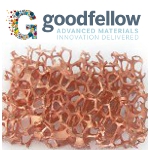 Copper foam from Goodfellow combines the outstanding thermal conductivity of copper with the structural benefits of a metal foam. These features are of particular interest to design engineers working in the fields of medical products and devices, defense systems and manned flight, power generation, and the manufacture of semiconductor devices. This product has a true skeletal structure with no voids, inclusions, or entrapments. A perennial favorite of Designfax readers.
Copper foam from Goodfellow combines the outstanding thermal conductivity of copper with the structural benefits of a metal foam. These features are of particular interest to design engineers working in the fields of medical products and devices, defense systems and manned flight, power generation, and the manufacture of semiconductor devices. This product has a true skeletal structure with no voids, inclusions, or entrapments. A perennial favorite of Designfax readers.
Learn more.
Full-color 3D-printing Design Guide from Xometry
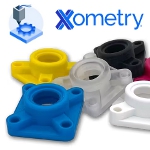 With Xometry's PolyJet 3D-printing service, you can order full-color 3D prints easily. Their no-cost design guide will help you learn about different aspects of 3D printing colorful parts, how to create and add color to your models, and best practices to keep in mind when printing in full color. Learn how to take full advantage of the 600,000 unique colors available in this flexible additive process.
With Xometry's PolyJet 3D-printing service, you can order full-color 3D prints easily. Their no-cost design guide will help you learn about different aspects of 3D printing colorful parts, how to create and add color to your models, and best practices to keep in mind when printing in full color. Learn how to take full advantage of the 600,000 unique colors available in this flexible additive process.
Get the Xometry guide.
Tech Tip: How to create high-quality STL files for 3D prints
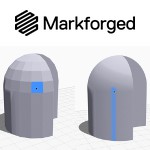 Have you ever 3D printed a part that had flat spots or faceted surfaces where smooth curves were supposed to be? You are not alone, and it's not your 3D printer's fault. According to Markforged, the culprit is likely a lack of resolution in the STL file used to create the part.
Have you ever 3D printed a part that had flat spots or faceted surfaces where smooth curves were supposed to be? You are not alone, and it's not your 3D printer's fault. According to Markforged, the culprit is likely a lack of resolution in the STL file used to create the part.
Read this detailed and informative Markforged blog.
Test your knowledge: High-temp adhesives
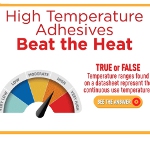 Put your knowledge to the test by trying to answer these key questions on how to choose the right high-temperature-resistant adhesive. The technical experts from Master Bond cover critical information necessary for the selection process, including questions on glass transition temperature and service temperature range. Some of the answers may surprise even the savviest of engineers.
Put your knowledge to the test by trying to answer these key questions on how to choose the right high-temperature-resistant adhesive. The technical experts from Master Bond cover critical information necessary for the selection process, including questions on glass transition temperature and service temperature range. Some of the answers may surprise even the savviest of engineers.
Take the quiz.
Engineer's Toolbox: How to pin a shaft and hub assembly properly
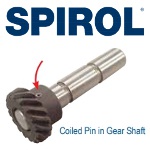 One of the primary benefits of using a coiled spring pin to affix a hub or gear to a shaft is the coiled pin's ability to prevent hole damage. Another is the coiled pin absorbs wider hole tolerances than any other press-fit pin. This translates to lower total manufacturing costs of the assembly. However, there are a few design guidelines that must be adhered to in order to achieve the maximum strength of the pinned system and prevent damage to the assembly.
One of the primary benefits of using a coiled spring pin to affix a hub or gear to a shaft is the coiled pin's ability to prevent hole damage. Another is the coiled pin absorbs wider hole tolerances than any other press-fit pin. This translates to lower total manufacturing costs of the assembly. However, there are a few design guidelines that must be adhered to in order to achieve the maximum strength of the pinned system and prevent damage to the assembly.
Read this very informative SPIROL article.
What's new in Creo Parametric 11.0?
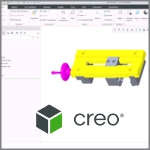 Creo Parametric 11.0 is packed with productivity-enhancing updates, and sometimes the smallest changes make the biggest impact in your daily workflows. Mark Potrzebowski, Technical Training Engineer, Rand 3D, runs through the newest functionality -- from improved surface modeling tools to smarter file management and model tree navigation. Videos provide extra instruction.
Creo Parametric 11.0 is packed with productivity-enhancing updates, and sometimes the smallest changes make the biggest impact in your daily workflows. Mark Potrzebowski, Technical Training Engineer, Rand 3D, runs through the newest functionality -- from improved surface modeling tools to smarter file management and model tree navigation. Videos provide extra instruction.
Read the full article.
What's so special about wave springs?
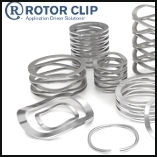 Don't settle for ordinary springs. Opt for Rotor Clip wave springs. A wave spring is a type of flat wire compression spring characterized by its unique waveform-like structure. Unlike traditional coil springs, wave springs offer an innovative solution to complex engineering challenges, producing forces from bending, not torsion. Their standout feature lies in their ability to compress and expand efficiently while occupying up to 50% less axial space than traditional compression springs. Experience the difference Rotor Clip wave springs can make in your applications today!
Don't settle for ordinary springs. Opt for Rotor Clip wave springs. A wave spring is a type of flat wire compression spring characterized by its unique waveform-like structure. Unlike traditional coil springs, wave springs offer an innovative solution to complex engineering challenges, producing forces from bending, not torsion. Their standout feature lies in their ability to compress and expand efficiently while occupying up to 50% less axial space than traditional compression springs. Experience the difference Rotor Clip wave springs can make in your applications today!
View the video.
New Standard Parts Handbook from JW Winco
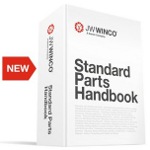 JW Winco's printed Standard Parts Handbook is a comprehensive 2,184-page reference that supports designers and engineers with the largest selection of standard parts categorized into three main groups: operating, clamping, and machine parts. More than 75,000 standard parts can be found in this valuable resource, including toggle clamps, shaft collars, concealed multiple-joint hinges, and hygienically designed components.
JW Winco's printed Standard Parts Handbook is a comprehensive 2,184-page reference that supports designers and engineers with the largest selection of standard parts categorized into three main groups: operating, clamping, and machine parts. More than 75,000 standard parts can be found in this valuable resource, including toggle clamps, shaft collars, concealed multiple-joint hinges, and hygienically designed components.
Get your Standard Parts Handbook today.
Looking to save space in your designs?
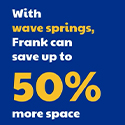 Watch Smalley's quick explainer video to see how engineer Frank improved his product designs by switching from traditional coil springs to compact, efficient wave springs. Tasked with making his products smaller while keeping costs down, Frank found wave springs were the perfect solution.
Watch Smalley's quick explainer video to see how engineer Frank improved his product designs by switching from traditional coil springs to compact, efficient wave springs. Tasked with making his products smaller while keeping costs down, Frank found wave springs were the perfect solution.
View the video.
Top die casting design tips
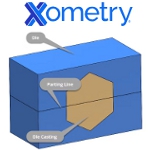 You can improve the design and cost of your die cast parts with these top tips from Xometry's Joel Schadegg. Topics include: Fillets and Radii, Wall Thicknesses, Ribs and Metal Savers, Holes and Windows, Parting Lines, and more. Follow these recommendations so you have the highest chance of success with your project.
You can improve the design and cost of your die cast parts with these top tips from Xometry's Joel Schadegg. Topics include: Fillets and Radii, Wall Thicknesses, Ribs and Metal Savers, Holes and Windows, Parting Lines, and more. Follow these recommendations so you have the highest chance of success with your project.
Read the full Xometry article.
What's the latest from 3D Systems? Innovations for different industries, processes
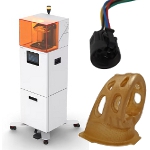 3D Systems unveiled several new solutions at the RAPID+TCT 2025 show in April designed to change the way industries innovate. From new 3D printers and materials for high-mix, low-volume applications to marked improvements in how investment casting can be done, learn what is the state of the art from the original inventors of 3D printing.
3D Systems unveiled several new solutions at the RAPID+TCT 2025 show in April designed to change the way industries innovate. From new 3D printers and materials for high-mix, low-volume applications to marked improvements in how investment casting can be done, learn what is the state of the art from the original inventors of 3D printing.
Read the full article.
Clever! Indexing plungers with chamfered pins
 JW Winco has developed a new type of indexing plunger -- GN 824 -- that can independently latch into edges and grooves. This is made possible by a chamfered plunger pin. When the chamfered pin encounters a raised latching geometry, it retracts and then springs back out again once it reaches the latching point. This new indexing plunger can be ordered with axial thread for fastening and a black plastic knob for operating the indexing plunger. In a clever design, the plunger pin can be adjusted by 360 degrees to ensure that it encounters the mating surface perpendicularly. This hardware is well suited for transport frames, mechanisms, or covers that need to be locked in place quickly and securely, especially without the need for manual intervention.
JW Winco has developed a new type of indexing plunger -- GN 824 -- that can independently latch into edges and grooves. This is made possible by a chamfered plunger pin. When the chamfered pin encounters a raised latching geometry, it retracts and then springs back out again once it reaches the latching point. This new indexing plunger can be ordered with axial thread for fastening and a black plastic knob for operating the indexing plunger. In a clever design, the plunger pin can be adjusted by 360 degrees to ensure that it encounters the mating surface perpendicularly. This hardware is well suited for transport frames, mechanisms, or covers that need to be locked in place quickly and securely, especially without the need for manual intervention.
Learn more.
'Engineer of the Year' chosen by largest aerospace society
Humberto "Tito" Silva III, a Sandia National Laboratories researcher, has been named Engineer of the Year by the American Institute of Aeronautics and Astronautics (AIAA), the world's largest aerospace technical society.
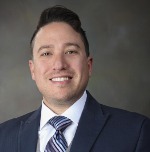
Humberto "Tito" Silva. [Photo by Lonnie Anderson, courtesy Sandia National Laboratories]
Selected by a committee of his peers, Silva was cited for improving failure-rate predictions of aerospace flight systems as they reenter Earth's atmosphere. The work helps direct engineers to attack the worst problems first for reentry rockets, spaceships, and satellites.
Silva's procedure, which he has dubbed "Tito's full-circle analysis methodology," uses computer modeling to determine the fewest number of computer simulations and physical experiments needed to get trusted data on a project.
"We were able to have high statistical confidence in our results. These were analogous to those achieved by researchers using many orders of magnitude more computational simulations and physical experiments," Silva said. "Our method saves money and time."
AIAA president Basil Hassan, who is also the deputy chief research officer at Sandia, said, "Tito's work helps ensure the safety, security, and reliability of the nuclear deterrent by helping to understand potential uncertainties in extreme thermal environments. The methodologies developed here could also be used for other entry and reentry-type applications that similarly concern engineers."
Silva's award will be presented in August at the AIAA Aerospace Spotlight Awards Gala, an annual event the organization describes as "recognizing the most influential and inspiring individuals in aerospace."
Succeeding with failure
Silva credits his unusually varied background, which includes study in several engineering and science fields, for endowing him with a jack-of-all-trades outlook that connects with the deeper perspective of researchers who self-confine to particular research areas.
"Many scientists deep-dive into subfields," he said. "My bread-and-butter is that I bring a different perspective. Technical experts fill in my knowledge gaps, and I fill in ones they haven't thought of." He describes himself as an "inside consultant," bridging subcategories in computer science, project management, and aerospace, mechanical, chemical, and electrical engineering.
Acting as a catalyst in a variety of fields doesn't blur his research focus, which is thermal science -- "pretty much the jell for all the work I've done," he said.
His teams feed data from modeling and physical experiments -- limited in number to keep costs down -- into computer models expected to simulate the actual effects. Results from the models are then used in experiments to see how derived data matches that from physically harvested data.
The work often shows considerable overlap between theory-based and experimental graphs, which lends weight to Silva's failure-rate predictions.
Super-sleuthing the cosmos
Working from an Earth-bound lab, Silva doesn't minimize the difficulty of determining events in outer space. The sleuth-like deductions are similar, he says, "to determining why an iPhone thermally or electrically fails in a box, if the box is in a closet, the closet in a room, the room in a building, the building on a barge in the hold of an aircraft carrier ..."
His first move is to simulate the environment, including the season of the year and time of day.
Then, there's the equipment. "If the reentry body is made partly of stainless steel, we think we know its thermal conductivity. But there's material variability from different factories, so we have uncertainty in how that affects our vehicle. So, we use a range of possible figures," he said.
Solving questions about a particular system entering Earth's atmosphere, subspecialists were needed to find the sweet spot between different forms of heat transfer. "So, we did a computational experiment on how to use all the test equipment most frugally. We needed to determine the optimum amount of experiments and computer simulations, so we weren't running, say, 5 million computer simulations and 5,000 experiments."
Using these deliberately limited means, his team found a way to map the probability space of all possible outcomes. "Then we found a condition with our model that stressed the system. We used that in the computer domain and then again in the experimental domain in an iterative fashion. That gave us our result."
Said Darcie Farrow, a former systems engineer overseeing nuclear weapon sustainment, "The multiple technical advances initiated by Tito are improving nuclear safety assessments as well as aerodynamic models for a wide range of flight systems."
Silva also has initiated collaborations with Los Alamos National Laboratory resulting in nuclear weapon system models that capture the response of both labs' components in fire environments for the first time, she said.
A peaceful past and stimulating future
Belying the future complexity of his work, Silva grew up in the visually simple farming country around El Paso, TX. There were no big buildings; he could see for miles.
The open fields contributed to his interest in outer space, he says: "It's easy to dream about the stars, growing up with only cotton fields in your backyard."
But his life grew more complicated when he left astrophysics as he started graduate school: "At the time, there was too much uncertainty in [astrophysics]," he said. "You couldn't experimentally prove that there is such a thing as black hole -- or, at least, back then there wasn't any experimental or tangible proof as there is now."
The space shuttle Columbia disaster in early February 2003 got him back into studying space -- specifically, aerospace engineering -- to finish his graduate school education. Silva said he "saw it in real time across the sky" as he was driving across Texas.
The emotional impact of the sight, reinforced by Texas radio stations' repeated playing of Stevie Ray Vaughan's song "The Sky is Crying," created a memory that he feels forged his future path.
"I knew then," he said, "that I wanted to apply uncertainty quantification to safety-driven problems and that aerospace engineering was a perfect field for that application. It was like a homecoming for me ... coming back to what I always loved."
The earlier disaster of the space shuttle Challenger was Silva's initial propellant into thoughts of aerospace. "The memory of watching that disaster -- also in real time with my principal and my classmates while in school -- left a huge impression on me as a young boy."
He maintains his interest in a number of academic fields in which he still takes classes and teaches to this day, he said.
But in Silva's life, he said, "It's clear that aerospace tragedies have had their way with my destiny."
Source: Sandia
Published June 2021
Rate this article
View our terms of use and privacy policy

